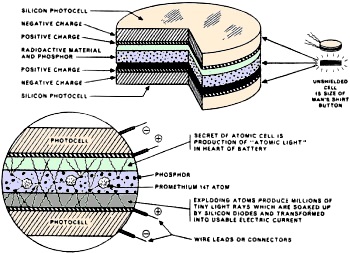|
May 1957 Radio & TV News
 [Table
of Contents] [Table
of Contents]
Wax nostalgic about and learn from the history of early
electronics. See articles from
Radio & Television News, published 1919-1959. All copyrights hereby
acknowledged.
|
Evidently the procurement cost
of promethium 147 never fell low enough to make it affordable by the masses. If
it had, though, according to this 1957 Radio & TV News magazine article we might all have been wearing nuclear-powered
Elgin National Watch Company
timepieces in the last century rather than Timex. Beta particles from the radioactive
decay of promethium 147 impinge upon special crystalline components that generate
enough electricity in this cell to power a watch for five years or more. I wonder,
had it been successful, how long it would have been before 'that persistent rash'
on people's wrists and upper thighs (for pocket watch users) was determined to be
due not to a metal allergy, but to a radiation burn? It is amazing such schemes
were ever considered, but then again I still have dental fillings with lead amalgams
in them.
Miniature Atomic-Powered Battery
Delivers continuous power for at least live years.

Man's fingers loom large holding tiny battery which in its shielded form shown
above is no bigger than a cuff link.

Life performance, showing maximum currents delivered over long period of time.
Atomic energy has come a giant stride closer to casual use by the man on the
street with the recent announcement of a tiny nuclear-powered battery that will
deliver useful electrical current for at least five years.
It is the first such device to harness radioactive materials in a way that makes
them safe for extensive personal use without special precautions, say inventors
of the cell. Although not yet available commercially, the long-life battery will
eventually be used in such products as electrically operated wrist watches, hearing
aids, miniature portable radios, and civil-defense warning receivers for the home
that can operate around the clock for years.
The atom cell, developed by Elgin National Watch Co. in conjunction with Walter
Kidde Nuclear Labs. Inc., Garden City, N. Y., operates for a period of time that
is determined by the rate at which the radioactive promethium 147 disintegrates.
This presently scarce isotope, which was reclaimed from the atomic bomb "ash heap,"
is now believed to have a half-life of about 2 1/2 years. Present high cost of promethium
147 will delay commercial availability of the atomic cell, although extensive expansion
of production facilities by the A.E.C. has already started.
The two-stage process of producing electrical energy within the cell involves
a tiny amount of phosphor, or crystalline substance that converts into light energy
the beta energy particles emitted by the radioactive isotope. A silicon diode, which
actually operates as a photocell, then changes this light into usable electrical
current.
The Elgin-Kidde cell uses a transparent container of radiation-resistant plastic
to seal the light source, which gives off red and infrared radiation. Photocells,
of a modified solar type, may be connected in various ways to produce output voltages
from 1/4 to 1 volt, with an output power of 20 μw. when new, falling to 5 μw.
after 5 years. The present cell is housed in a compact metal protective shielding.
Laboratory samples to date have delivered 20 μa. of current. According to
present target specifications, a cell will be made to deliver 40 μa of current
by the use of larger amounts of the radioactive material.

Beta radiation converted to light acts on photocells and
produces electricity.
Posted February 8, 2022
(updated from original post on 8/1/2014)
|












